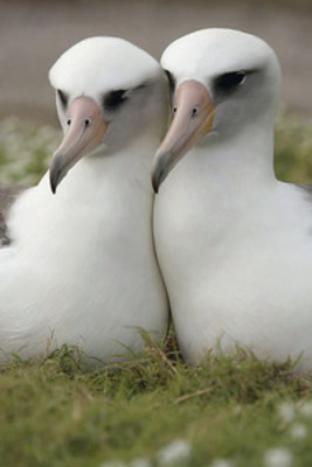Published in the Ocean Watch column, Honolulu Star-Advertiser © Susan Scott
January 16, 2012

Seabirds like these Laysan albatrosses are critical to the ecosystem.
Last year, after I gave a slide show about Midway’s albatrosses to a Honolulu seniors group, a woman raised her hand. “What are they good for?” she asked.
I talked about the birds’ grace and beauty, the benefits of wildlife refuges and how living with wild animals can give us perspective regarding our place on the planet.
“But can you eat them?”
Appalled, I snapped, “No, you cannot. Seabirds are protected by law.”
“Well, then, why spend money on them?”
As shocking as the question is to us seabird lovers, it’s one a lot of people have. Why spend tax money on animals that aren’t edible? And when the world’s oceans are down to 10 percent of their original numbers of fish and squid, how do we justify protecting millions of birds that eat fish and squid?
Seabirds are such a wonderful part of my life that I get emotional and tongue-tied over questions like these. Not Sylvia Earle, former head scientist for the National Oceanic and Atmospheric Administration and one of several people instrumental in getting the Northwestern Hawaiian Islands declared a national marine monument.
I had the good fortune to be at Midway during Earle’s visit there and asked her what she says when people wonder why we should care about a bunch of birds.
“I say, ‘Do you like to breathe?'” she said. “Because air is not free. Billions of tiny drifting plants in the ocean are constantly taking in carbon dioxide and giving off oxygen.”
And in making the oceans healthy, we can’t pick and choose. It doesn’t work to save fish but leave nonfood animals, such as seals, seabirds and whales, to sink or swim. Each ocean is an enormous, complicated whole. Marine organisms evolved together and need each other to continue making air and producing food.
“Land plants make oxygen, too, but the heart of the process is in the oceans,” Earle said. “Which part of your own heart would you choose to cut out?”
After discussing oxygen production and the holistic health of the seas in my next slide show, I will also talk about another human need that seabirds fulfill: peace of mind.
There’s nothing like having a curious albatross gently check out my toes with its beak to make me feel happy to be alive. Watching these birds kiss and cuddle, sing and dance, soar like angels and baby their chicks is as good as taking a Valium. With albatrosses around, who needs drugs?
We’re an arrogant species, thinking that everything on this planet is about us. “What are humans good for?” I should have asked my questioner. I would say for appreciating albatrosses.
©2012 Susan Scott